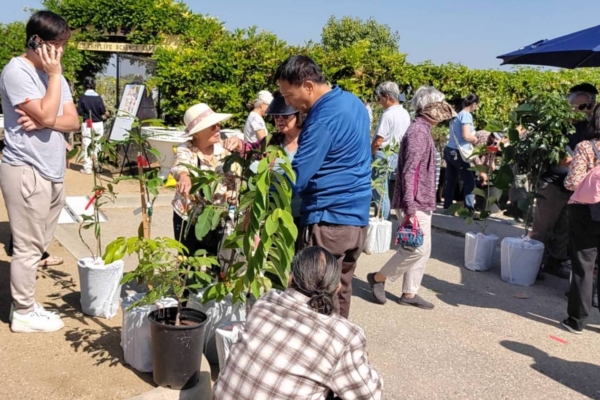In Southern California, where the climate is ideal and almost all seasons can yield a variety of fruits and vegetables, many Chinese people enjoy planting flowers and grass in their backyard. With the arrival of autumn and winter, how should one cultivate fruits and vegetables? Farm volunteers Chen Jianrong and Li Xiaoyan share their experiences on planting fruit and vegetable seedlings during the fall and winter seasons, as well as tips on creating a backyard garden.
Chen Jianrong is usually found at the Walnut City Life Science Farm, where he and other teachers work with volunteers and students to cultivate the land. Through hands-on experiences, they share techniques such as soil preparation, seedling nurturing, grafting, pruning, and more, while building friendships with like-minded individuals. Chen mentions that Taiwanese immigrants often favor tropical fruit trees like papayas, guavas, and guava, which are susceptible to cold damage in the fall and winter. Therefore, it is essential to take measures such as protecting them from the cold and wind. Covering the plants with dry straw or plastic sheets during colder nights, and ensuring proper aeration during the daytime, using sunshade nets or simple fences for insulation, are recommended.
Before the arrival of fall and winter, it is crucial to use organic or potassium fertilizers in moderation to enhance the cold resistance of fruit trees. Properly pruning old leaves and dead branches can reduce water loss from the trees, ensuring healthy growth during the autumn and winter months. While California’s rainy season mainly falls in the winter, particularly between November and March, irrigation and watering should not be overlooked during the fall and winter. Adequate watering can increase soil moisture and reduce soil temperature fluctuations.
Tropical fruit trees thrive in humid conditions, and although Southern California’s climate is suitable, it may lack sufficient humidity. Therefore, it is crucial to provide supplemental watering and fertilization when planting trees. Apart from purchasing ready-made fertilizers, you can also make milk enzymes from expired milk by adding water and sugar to provide plants with different nutrients.
Li Xiaoyan suggests that during the fall and winter seasons, with lower temperatures and shorter daylight hours, it is ideal to plant cold-resistant or fast-growing vegetables and fruits. She recommends planting cabbage, lettuce, spinach, radishes, onions, pumpkins, which are seasonal vegetables suitable for fall and winter cultivation. These vegetables are less prone to pests and relatively easy to grow.
Fruit trees require time to grow and yield fruit. Citrus fruits like oranges and grapefruits harvested in fall and winter are well-suited to low-temperature environments. Li also encourages consuming seasonal fruits like mandarins, oranges, or strawberries during the fall and winter to supplement the body with essential vitamins.
Engaging in gardening not only allows people to spend time outdoors but also helps in stress reduction and promotes physical health. Harvested fruits and vegetables can be used for personal consumption, shared with friends and family, or even sold. Long-term cultivation of a backyard garden not only saves money but can also generate income, foster connections with like-minded individuals, and involve the whole family in a rewarding activity.

